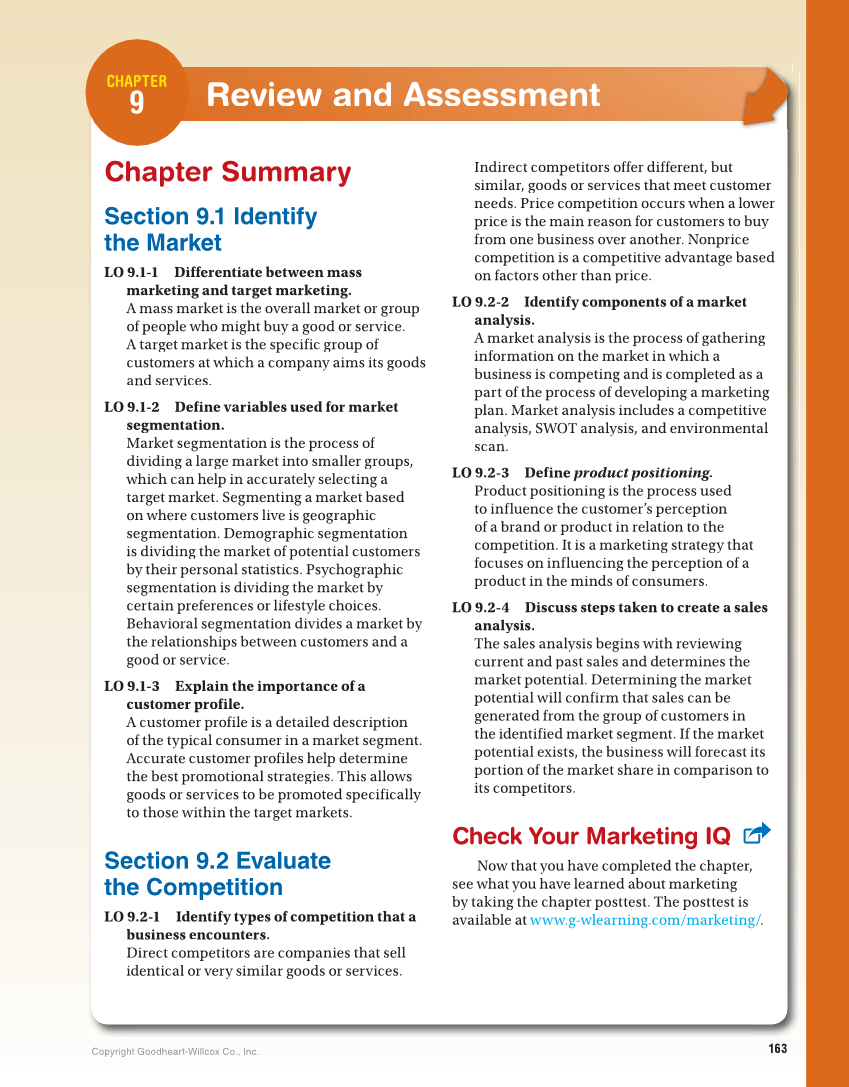Review and Assessment CHAPTER 9 163 Copyright Goodheart-Willcox Co., Inc. Chapter Summary Section 9.1 Identify the Market LO 9.1-1 Differentiate between mass marketing and target marketing. A mass market is the overall market or group of people who might buy a good or service. A target market is the specific group of customers at which a company aims its goods and services. LO 9.1-2 Define variables used for market segmentation. Market segmentation is the process of dividing a large market into smaller groups, which can help in accurately selecting a target market. Segmenting a market based on where customers live is geographic segmentation. Demographic segmentation is dividing the market of potential customers by their personal statistics. Psychographic segmentation is dividing the market by certain preferences or lifestyle choices. Behavioral segmentation divides a market by the relationships between customers and a good or service. LO 9.1-3 Explain the importance of a customer profile. A customer profile is a detailed description of the typical consumer in a market segment. Accurate customer profiles help determine the best promotional strategies. This allows goods or services to be promoted specifically to those within the target markets. Section 9.2 Evaluate the Competition LO 9.2-1 Identify types of competition that a business encounters. Direct competitors are companies that sell identical or very similar goods or services. Indirect competitors offer different, but similar, goods or services that meet customer needs. Price competition occurs when a lower price is the main reason for customers to buy from one business over another. Nonprice competition is a competitive advantage based on factors other than price. LO 9.2-2 Identify components of a market analysis. A market analysis is the process of gathering information on the market in which a business is competing and is completed as a part of the process of developing a marketing plan. Market analysis includes a competitive analysis, SWOT analysis, and environmental scan. LO 9.2-3 Define product positioning.g Product positioning is the process used to influence the customer’s perception of a brand or product in relation to the competition. It is a marketing strategy that focuses on influencing the perception of a product in the minds of consumers. LO 9.2-4 Discuss steps taken to create a sales analysis. The sales analysis begins with reviewing current and past sales and determines the market potential. Determining the market potential will confirm that sales can be generated from the group of customers in the identified market segment. If the market potential exists, the business will forecast its portion of the market share in comparison to its competitors. Check Your Marketing IQ Now that you have completed the chapter, see what you have learned about marketing by taking the chapter posttest. The posttest is available at www.g-wlearning.com/marketing/./
